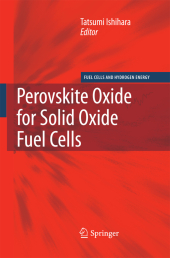 Neuerscheinungen 2014Stand: 2020-02-01 |
Schnellsuche
ISBN/Stichwort/Autor
|
Herderstraße 10
10625 Berlin
Tel.: 030 315 714 16
Fax 030 315 714 14
info@buchspektrum.de |

Tatsumi Ishihara
Perovskite Oxide for Solid Oxide Fuel Cells
Herausgegeben von Ishihara, Tatsumi
2009. 2014. xvi, 302 S. 31 Tabellen. 235 mm
Verlag/Jahr: SPRINGER, BERLIN; SPRINGER US; SPRINGER 2014
ISBN: 1-489-98278-7 (1489982787)
Neue ISBN: 978-1-489-98278-0 (9781489982780)
Preis und Lieferzeit: Bitte klicken
The main purpose of this book is to explain the current status of intermediate temperature Solid Oxide Fuel Cells using perovskite. The volume´s main focus is on the application of perovskite oxide for electrode and electrolyte of solid oxide fuel cells.
Fuel cell technology is quite promising for conversion of chemical energy of hydrocarbon fuels into electricity without forming air pollutants. There are several types of fuel cells: polymer electrolyte fuel cell (PEFC), phosphoric acid fuel cell (PAFC), molten carbonate fuel cell (MCFC), solid oxide fuel cell (SOFC), and alkaline fuel cell (AFC). Among these, SOFCs are the most efficient and have various advantages such as flexibility in fuel, high reliability, simple balance of plant (BOP), and a long history. Therefore, SOFC technology is attracting much attention as a power plant and is now close to marketing as a combined heat and power generation system. From the beginning of SOFC development, many perovskite oxides have been used for SOFC components; for example, LaMnO -based oxide for the cathode and 3 LaCrO for the interconnect are the most well known materials for SOFCs. The 3 current SOFCs operate at temperatures higher than 1073 K. However, lowering the operating temperature of SOFCs is an important goal for further SOFC development. Reliability, durability, and stability of the SOFCs could be greatly improved by decreasing their operating temperature. In addition, a lower operating temperature is also beneficial for shortening the startup time and decreasing energy loss from heat radiation. For this purpose, faster oxide ion conductors are required to replace the conventional Y O -stabilized ZrO 2 3 2 electrolyte. A new class of electrolytes such as LaGaO is considered to be 3 highly useful for intermediate-temperature SOFCs.
Structure and Properties of Perovskite Oxides.- Overview of Intermediate-Temperature Solid Oxide Fuel Cells.- Ionic Conduction in Perovskite-Type Compounds.- Oxide Ion Conductivity in Perovskite Oxide for SOFC Electrolyte.- Diffusivity of the Oxide Ion in Perovskite Oxides.- Structural Disorder, Diffusion Pathway of Mobile Oxide Ions, and Crystal Structure in Perovskite-Type Oxides and Related Materials.- Perovskite Oxide for Cathode of SOFCs.- Perovskite Oxide Anodes for SOFCs.- Intermediate-Temperature Solid Oxide Fuel Cells Using LaGaO3.- Quick-Start-Up Type SOFC Using LaGaO3-Based New Electrolyte.- Proton Conductivity in Perovskite Oxides.- Proton Conduction in Cerium- and Zirconium-Based Perovskite Oxides.- Mechanisms of Proton Conduction in Perovskite-Type Oxides.- Intermediate-Temperature SOFCs Using Proton-Conducting Perovskite.- LaCrO3-Based Perovskite for SOFC Interconnects.


